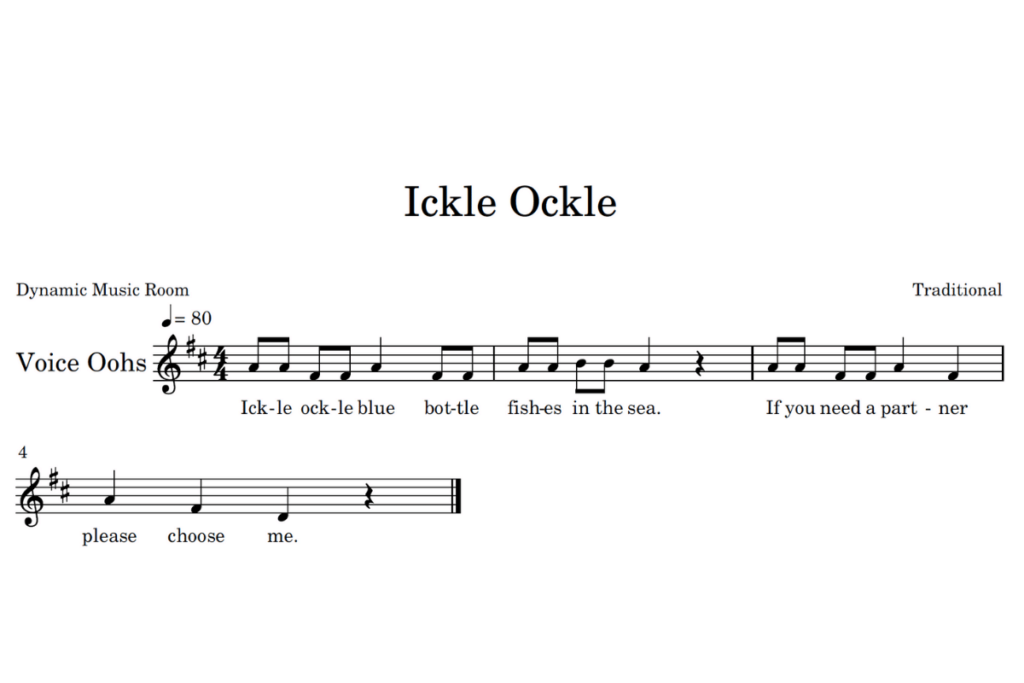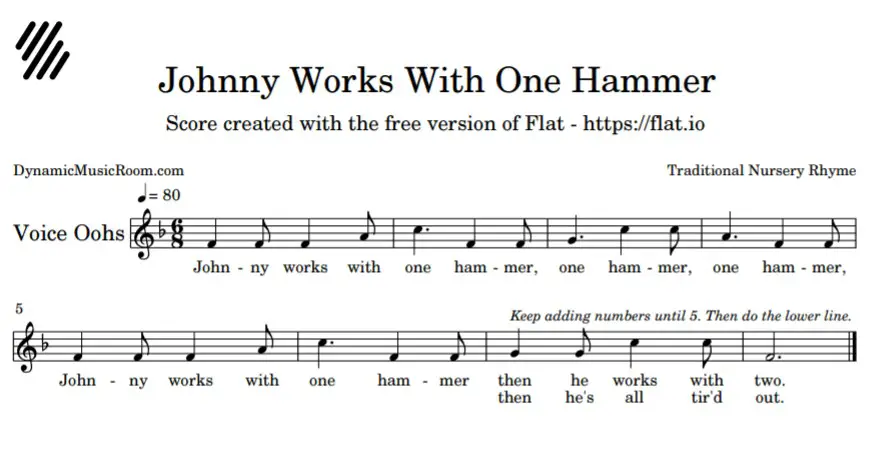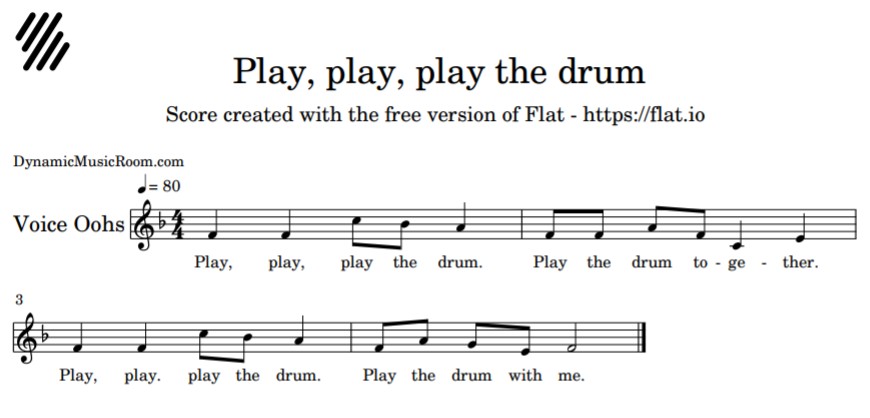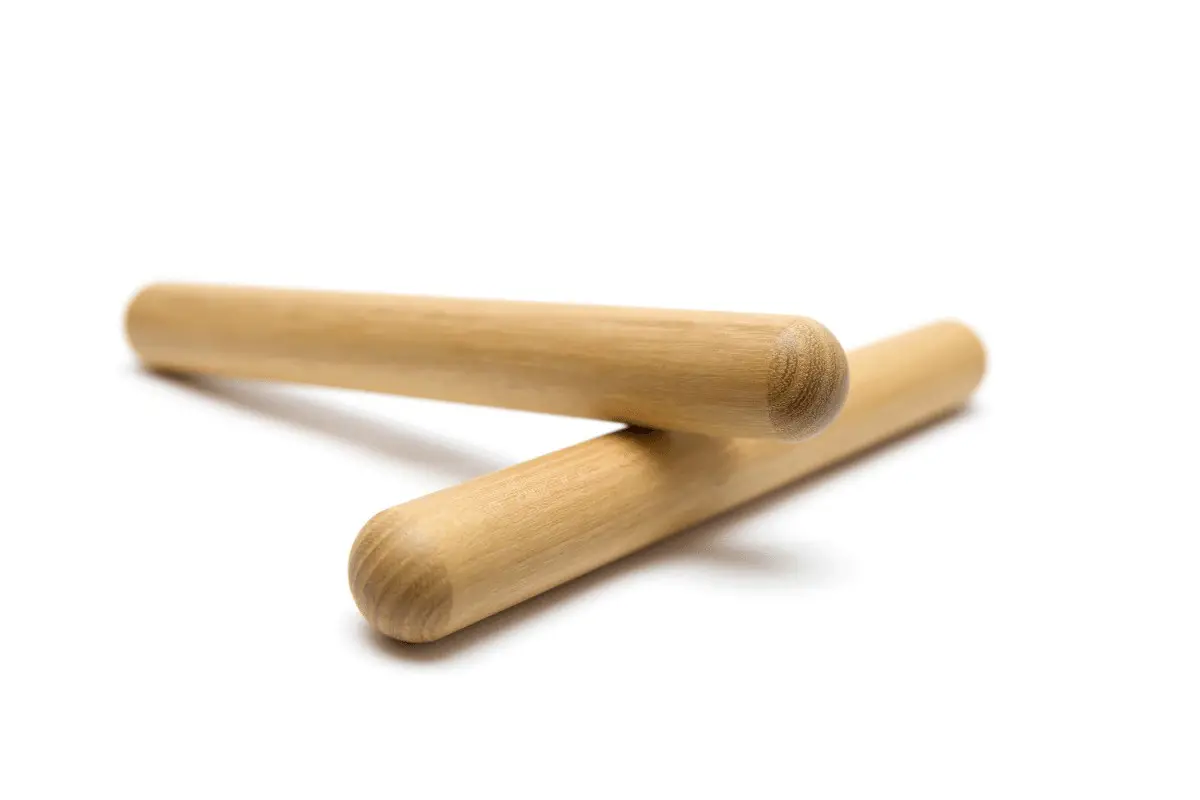Rhythm sticks are always one of my go-to percussion instruments to use with any age level, especially in preschool music classes.
They are fun to use and provide a good sound.
For musical skills, they can be used to develop steady beat and rhythm skills.
For other areas, they help a lot with fine motor control and spatial awareness.
But how do we use them?
I pulled from my lesson plans to come up with 21 of my favorite musical rhythm stick activities for preschoolers.
Here’s the list (Read on for more details):
- If You’re Happy And You Know It
- Ickle Ockle Blue Bottle
- Johnny Works With One Hammer
- My Mother, Your Mother
- Who’s the Leader? (Echo Each Other)
- Rhythm Stick Conversation
- Musical Statues
- Make A Rainstorm
- Simon Says
- Mirror Movement
- Hickety Tickety Bumblebee
- Echo Me
- Follow The Drum Major
- Pass The Sticks
- Timbre Sort (What Sounds Like A Rhythm Stick?)
- Rhythm Stick Dynamics
- B-I-N-G-O
- Bumping Up And Down In My Little Red Wagon
- Baby Shark
- Criss-Cross Beat
- Play, Play, Play the Sticks
Read ahead for the details on this list of rhythm stick activities.
Table of Contents
If You’re Happy And You Know It
Who doesn’t know this song?
It’s a super fun one, and it makes for a good introduction to rhythm sticks.
All you need to do is add rhythm sticks to the song or make up new lyrics including rhythm sticks.
If you’re happy and you know it tap your sticks (click, click!).
Pro-tip: Do the song without the sticks first. Then add the sticks in.
Ickle Ockle Blue Bottle
I love this silly song.
It’s one of my favorite songs for preschool, though I’ll usually save it for first grade.
Still, it works great with toddlers, 3 year olds, and 4 year olds.
Check out the notation at the bottom.
The movement for this song is as follows:
- Everyone stands in a circle.
- One person skips around the middle while the class sings the song (and pats the beat).
- At the words, “Please choose me,” the middle person picks someone and switches spots with them.
- The song repeats with the new person.
- Continue until everyone has had a turn.
To make this a rhythm sticks song, I would have them simply click the steady beat.
If you want to have them play the words (rhythm), that’s fine, but I wouldn’t be too worried about it with this age group.

Johnny Works With One Hammer
Johnny Works With One Hammer is a fun additive game and song.
Students repeat the song, adding more motions until they are too many!
It’s also great for counting, and we know how much of a difference music makes in helping learning counting!
Here are the moves:
- Tap leg with the right hand
- Tap legs with both hands
- Bounce right foot and tap both legs with hands
- Bounce both feet and tap both legs
- Nod your head, bounce your legs, and tap your hands
With rhythm sticks, I have students simply tap the beat in different places.
I may change the words to something like:
Johnny taps the floor now, floor now, floor now…

My Mother, Your Mother
I love chants with rhythm, and this one is a favorite rhythm stick activity of mine.
It’s also featured on my list of egg shaker songs.
It’s a chant, so you say the words with a steady beat.
My mother, your mother, love across the way.
Every day they have a chat, and this is what they say.
After you play the beat with the sticks during this first part, you have the young children copy you during the second part.
I like to have them echo the words of a conversation while clicking the rhythm patterns.
Here’s an example:
Hey, my good friend!
It’s so good to see you.
What are you up to?
I am going shopping.
What are you shopping for?
Cake and ice cream.
Yummy yummy yummy!
Have a nice day!
Come up with more conversations and echo each phrase.
Copying text is the first step to teaching rhythm.
Note: Each click to match the syllables of the words.
Who’s the Leader? (Echo Each Other)
Pair up your students (after you’ve had them echo you with other music activities).
Pick one to be the leader and the other to be the echo.
Have them echo each other, switching roles every couple of minutes.
The leaders tap sticks and say the rhythm of the words.
Pro-tip: Give one student the pair of red sticks and the other one blue. Then you can say who’s the leader by color quickly.
Pro-tip #2: If they are struggling to come up with words to give as an echo, tell them to use the phrase: “I like ___.”
Have them say foods, TV shows, movies, etc.
Rhythm Stick Conversation
As a further extension of the echoing exercise, we can have kids improvise new patterns by connecting rhythms to words.
I like to also tie this in with the My Mother, Your Mother activity.
I only do this after we’ve played that game quite a few times.
Then, I ask students to pair up or make groups of three and “talk to each other.”
They should speak and play the words they say on their rhythm sticks.
Conversation is a great way to develop a sense of rhythm.
(It’s also a great time to emphasize social skills and discuss how you wait to speak until the other person is finished.)
Bonus: If you listen in to their conversations, you’ll hear them use your polite phrases that you hopefully modeled during the original activity.
It’s a joy to listen to!
Musical Statues
Movement is one of the best things we can offer to our preschoolers.
Adding rhythm sticks to a standard movement game gives them a prop to help hide any insecurities and encourage imaginative play.
Here’s how I usually play this game:
- Students walk around the room, playing their sticks to the beat and matching your drum.
- When you play a loud sound on a different instrument (I usually go with a bell or triangle, or the music stops if you don’t have one), they must freeze and make a statue.
- When you play your drum again, they play sticks with you and keep walking around.
- Repeat and add twists to the statues (make a statue with straight lines, curved lines, happy, sad, mad, scared, tall, short, with another person, etc.).
I spend quite a bit of time talking about feeling and showing them with your bodies and face for this one.
Even play-modeling appropriate ways to act out or process feelings is critical at this age level.
For example, I’ll have my statues go through a mini-story about a friend who didn’t want to play with them (mad statues), how they then walked around to cool off (sad), they were worried they lost a friend (scared), and after talking, they became friends again (happy).
This is great for emotional development.
Make A Rainstorm
Rhythm sticks make a cool timbre or type of sound.
When played in different ways, they make different sounds.
Have students mirror you through a series of motions to make a storm-like sound:
- Clicking tongues
- Clicking sticks together
- Tapping on shoes
- Stomping feet
- …and back up again
This makes a great addition to a story or a calming way to end music time.
Simon Says
Who doesn’t love Simon Says?
It’s one of the fun ways to practice focus and body control with preschoolers.
Use the rhythm sticks as a prop for different moves as a new twist on a game they probably already like to play.
The moves you pick work on fine motor skills and gross motor skills, so do a bit of both to help all your students.
Warning! Avoid doing anything that has them tap their face or nose. Someone might hit their face too hard and get hurt (this may have happened to me…).
Mirror Movement
Along the same lines of focus and body control, I love to have students mirror me to move with classical music.
The slow moves give them something to focus on and make it a challenge while they’re exposed to a new style of music.
I first have them make the moves without any props, but then I’ll add in rhythm sticks or scarves for an extension.
One of my favorites to do this with is the “Surprise Symphony.”
Check out these two articles with more classical music and lessons:
Hickety Tickety Bumblebee
Names are important for kids and adults.
Research shows we respond positively to people who use our names more often than those who don’t.
On the first day of music, I play this game.
It features a first section where we say a little chant and play the beat:
Hickety tickety bumblebee
Will you say your name for me?
Then, four students say their names and play the rhythm sticks.
You do the first section again, and four more students each say their first name.
It’s great practice to get names (for you to practice) and let students get playing something right away.
Echo Me
Another simple twist to any of the different songs or chants or nursery rhymes you do in class is simply to add an “echo me” section.
Are you playing London Bridge? Add an echo section to this fun game.
Singing your ABCs? Add an echo section where you play rhythm sticks and spell words!
Rhythm sticks are perfect for adding a small extension, especially if you have them copy you.
All songs are echo games when you add this in.
Note: Another term for these is call and response songs.
Follow The Drum Major
One of the best types of music to move with to the beat is marches.
The leader of a marching band is called a drum major.
Use your imagination to lead your students in a marching band with steady beat moves to some great American Marches.
Anything by John Philip Sousa will work, but this is one of the best.
Pass The Sticks
If you need more fine motor skills in your life, make it a game to pass rhythm sticks around the circle.
This will be tough for the kids to do to the beat, so while I would sing a song while they pass, I wouldn’t be too worried about them lining up perfectly with the beat.
If you have really skinny rhythm sticks, it’ll be extra hard for them.
If you don’t have good sticks, get some thick wooden dowels for a similar effect.
Start with one stick to pass and see if you can add a couple more for a more complex game!
Timbre Sort (What Sounds Like A Rhythm Stick?)
Sorting and classifying is an important skill that is used a lot in life.
After playing rhythm sticks for a while, I like to take a step back and ask students to find things in the room that sound like rhythm sticks.
We’ll get a whole bunch of ideas from random things in the room and sort them into stick and non-stick piles.
Rhythm Stick Dynamics
Adding dynamics or volume to your rhythm stick playing takes control to a whole other level for preschool students.
I would add them to your normal songs and games and any of the rhythm activities on this list.
First, I would do a simple echo activity where I did something like this, and students echoed on their sticks:
- Play, play, play, play
- Soft, soft, soft, soft, soft
- Softer, softer, softer, softer
- Soft, soft, soft, soft,
- Play, play, play, play
- Strong, strong, strong, strong
- Stronger, stronger, stronger, stronger!
- Shhhhhhhhhhhhhhhhhh (rub sticks together)
Then, I’ll say something about how volume or dynamics can make music more interesting.
And then we’ll add dynamics to stuff they already know.
B-I-N-G-O
I love this song, and it’s perfect for preschool classrooms.
During the first part, you play the beat, and during the second part, you play the letters.
But each time you get to the name/letter part, you have to leave one out.
This is good practice for rest in music, too (and it takes a lot of self-control).
Bumping Up And Down In My Little Red Wagon
Raffi is a great performer of preschool music songs, so I encourage preschool teachers and music teachers to check out his work and use his songs if possible.
They’re all pretty great!
This song lends itself well to using the rhythm sticks with the song during the chorus and using the sticks to mime fixing the wagon during the second part.
Baby Shark
A big part of keeping kids engaged in music-making is harnessing their energy and finding the things they love.
Baby Shark is one of those things we should try to harness their enthusiasm for.
Add rhythm sticks for the moves and play the parts, and you’ll make it feel like a brand new music game for them.
Criss-Cross Beat
I’m all about twists and not reinventing the wheel.
Music teachers and preschool teachers, we are busy people, right?
Rather than searching for brand-new stuff every time, let’s get some more mileage out of what works for us with extensions.
Instead of doing a simple beat with any of our normal songs and lessons, add in a criss-cross beat and make them cross their arms to play the rhythm sticks on the floor.
And this is AMAZING for crossing the midline (a much harder skill), which activates different areas of the brain, especially in preschoolers, and leads to better brain development.
Read more of these music activities for kids.
Play, Play, Play the Drum (err…Sticks?)
Here’s another easy song to top you off.
Add in different motions and change the musical instruments to match the sticks.
If you want, have them play the sticks on different parts of their body or in different ways.
Extend the activity by using many of the extensions we’ve talked about.


